6 Best Scopes for .450 Bushmasters in 2024 – Reviews & Top Picks
Last Updated on

A “thumper” round like the .450 Bushmaster is all about hitting hard at relatively close ranges. The vision behind the .450 Bushmaster is a round that can be chambered in the AR-15 platform but still provide an immensely powerful punch within 200-250 yards. The thumper concept came from Col. Jeff Cooper, who loved the AR-15 platform but bemoaned the relatively small and weak 5.56 NATO round.
The projectile of the .450 Bushmaster is a blurred line away from a shotgun slug both in size and shape, and its go-to use is for hunting wild hogs (which are big and strong) and bears (which are bigger and stronger) at 200 yards or closer. The round will travel further than 200-250 yards, but its squat design causes the trajectory to drop and lose velocity rapidly after that point.
Comparing the .450 Bushmaster
Within 200 yards, the .450 Bushmaster packs even more stopping power than a .308 Winchester round with about the same amount of recoil. Compared to the more common 5.56 and .223 chambering of the AR-15, the .450 Bushmaster packs a wallop. Understanding the effective range, intended range, and power of the .450 Bushmaster is important to understanding what optics are the best fit.
Here are our reviews of some of the best scopes for .450 Bushmaster rifles.

A Quick Comparison of Our Favorites (2024 Update)
| Image | Product | Details | ||
|---|---|---|---|---|
| Best Overall |
 |
UTG 3-9X32 BugBuster Scope |
|
CHECK PRICE |
| Best Value |
 |
Centerpoint Optics 1-4x20 MSR Rifle Scope |
|
CHECK PRICE |
| Premium Choice |
 |
Leupold VX-Freedom 450 Bushmaster Riflescope |
|
CHECK PRICE |
 |
Vortex Optics Crossfire II Riflescopes |
|
CHECK PRICE | |
 |
Sig Sauer Whiskey Quadplex Riflescope |
|
CHECK PRICE |
The 6 Best Scopes for 450 Bushmasters
1. UTG 3-9X32 BugBuster Scope – Best Overall

The BugBuster comes in at the number one spot as best overall for a number of reasons. First, the magnification is a straightforward 3x-9x, which is perfect for the sub-200-yard range that you’ll be doing most of your shooting in with a .450 Bushmaster. The 9x magnification will also allow you to get out further on the rare occasion that you need to do so.
The BugBuster also has features you wouldn’t necessarily expect in a scope at this price point. It has a mil-dot reticle with both red and green illumination and an adjustable objective if you want to completely eliminate parallax at a certain distance. The turrets are both lockable and resettable, and the Emerald coating on the lenses gives pretty incredible light transmission, especially considering the price point.
It’s rainproof, fog-proof, and shock-proof, and has a wide field of view to boot. Overall, it’s a fantastic scope not only for the money, but even compared to optics much more expensive.
- 3x-9x magnification great for <200 yards
- Reticle illumination
- Adjustable parallax
- Resettable turrets
- Good image quality
- Durability may be lacking
- Image quality lags behind other options
2. Centerpoint Optics 1-4×20 MSR Rifle Scope – Best Value

If you’re looking for the best scope for .450 Bushmaster for the money, our pick is the Centerpoint Optics 1-4×20 MSR Rifle Scope. Centerpoint doesn’t have the name recognition of most of the other scopes on this list, but it’s an impressive scope for the low price point. It’s hard to find a quality LPVO for less than $100, and Centerpoint does well at this.
The real question is whether you want an LPVO for your .450 Bushmaster. If you’re taking shots out to 200 yards, then the 3 MOA center dot on this reticle will start to affect your ability to shoot with high accuracy because it will cover a little over 6 inches of your target. The 4x magnification also means that you will see targets at 200 yards roughly the same as you would at 50 yards with your naked eye.
If 4x is enough for the type of shooting you’re doing, then the Centerpoint is definitely our pick for the best scope for .450 Bushmaster for the money.
- Great price
- Durable
- Illuminated dot & circle style reticle
- Opens up to 1x for close range
- Limited to 4x magnification
- No cross-hairs for precise shooting
3. Leupold VX-Freedom 450 Bushmaster Riflescope – Premium Choice
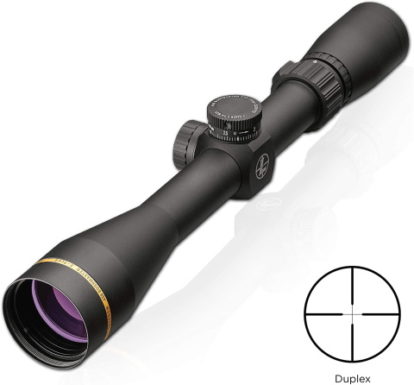
For those familiar with Leupold, it’s probably not surprising to see it as our premium choice. You get the standard (but highly versatile) 3-9x magnification range, but on the Leupold you get a 40 mm objective lens, Leupold’s Twilight Light Management System, and incredible durability.
Leupold glass is difficult to beat at any price point, so if light transmission, image clarity, sharpness, color fidelity, and durability are your priorities (and you’re willing to pay for them), the Leupold is a solid choice. This particular model is designed specifically for the .450 Bushmaster, so the turret adjustments are calibrated specifically for it. The reticle is just a simple duplex, though, with no bullet drop compensator (BDC) to help estimate holdovers.
If you’re looking for bells and whistles like reticle illumination, adjustable parallax, or resettable turrets, the VX-Freedom will not have them.
- Best image quality on the list
- Most rigorous stress tests on the list
- Duplex reticle
- Precise and accurate
- No reticle illumination
- No resettable turrets
- Expensive
4. Vortex Optics Crossfire II Riflescopes
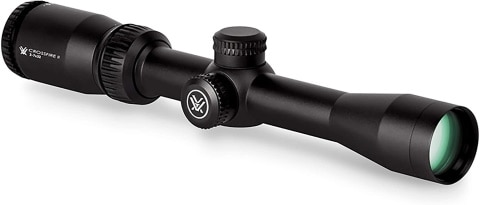
Of all the configurations of the Crossfire II, we would recommend the 2-7×32 for the .450 Bushmaster. This is because there are plenty of other options in the 3-9x range and 2-7x that may be even better suited for the range you’ll be shooting, since 7x is still enough to get out to 200 yards and the 2x allows you to take those close-range shots more comfortably.
One of the principal uses of the .450 Bushmaster is to hunt big game that isn’t afraid to hunt you right back, so if you miss your first shot and get charged by a wild animal, having a lower minimum magnification might make that closer shot a little easier. The Dead-Hold BDC is also a good choice since it can help with estimating holdovers quickly.
That said, the price and general lack of features keep the Crossfire II from taking the top spot. You do get a little better image quality than the UTG, but you may pay a lot for it and miss out on a lot of the things that make the UTG great.
- Multiple configurations available
- Multiple reticle choices
- Quick target acquisition
- Great image quality
- No parallax adjustment
- 2-7x version doesn’t have illuminated reticle option
5. Sig Sauer Whiskey Quadplex Riflescope
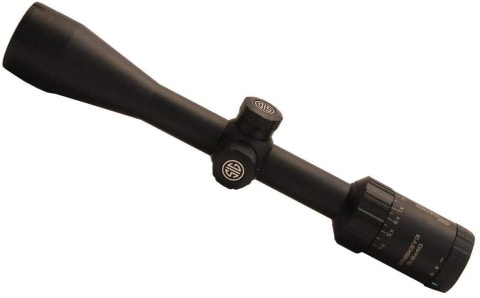
Most people don’t consider Sig Sauer to be an optics manufacturer, but they actually have some impressive scopes that have flown under the radar for a while. One of these is the Sig Sauer Whiskey 3. It’s tough, won’t lose zero, and has pretty great image quality. Sig follows the Leupold philosophy of keeping the features to a minimum in favor of doing the core functions to their utmost ability.
What this means is that you’ll get great light transmission and image clarity and the scope will hold zero even when subjected to heavy recoil, but that you won’t have a lot of the features we mentioned above like reticle illumination, adjustable parallax, or resettable turrets. If that sounds like the type of scope you want but you don’t want to pay Leupold money, then the Whiskey 3 could be a good choice.
The reticle is a simple duplex (although they call it a Quadplex), it’s waterproof up to 1 meter, fog-proof, and shock-proof. The adjustment clicks are .25 MOA and all the basics are done well on the Whiskey 3.
- Competitive price
- Good image quality
- Tough and durable
- Not a lot of features
- Simple duplex, no BDC
- Image quality lags behind Leupold and Vortex
6. Burris Fullfield II Ballistic Plex Scope
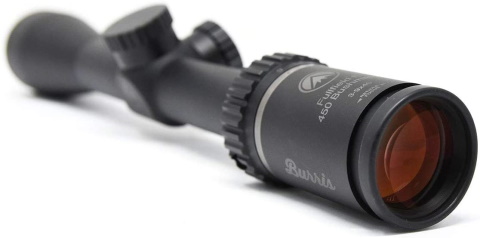
The Fullfield II is a solid scope. It’s the same 3-9x magnification that will really maximize your shooting out to 200 yards, and it has a duplex reticle with ballistic hash marks down the bottom line to estimate holdovers based on the distance you’re shooting. This is nice, but it’s also not particularly necessary if you zero at 100 yards and only every shoot out to 200 or 250 yards.
It’s also not calibrated specifically for .450 Bushmaster (despite the Fullfield II coming in a configuration specifically labeled “.450 Bushmaster”). The reticle is the same, evenly-spaced lines no matter what configuration you choose.
Even with that oddity, the Fullfield II is a great scope for the .450 Bushmaster because the hash marks can still be used once you learn the distances that the hash marks line up for, and the duplex reticle offers high precision and accuracy throughout the effective range of the .450. The glass is high quality, and the turret adjustments are smooth and intuitive.
- 3-9x magnification
- BDC lines on reticle
- Turrets are smooth and intuitive
- No customization for .450 Bushmaster
- No reticle illumination
- No adjustable parallax
- No resettable turrets
Related Read: 10 Best Rifle Scopes – Reviews & Top Picks
Buyer’s Guide – Choosing the Best Scopes for .450 Bushmasters
Features vs. Performance
As you get more familiar with scopes you start to notice two schools of thought: loading up as many features as possible or focusing on excelling at the core purpose of a scope. You can always get both, of course, if you are able to drop a significant sum on a rifle optic, but much of the time you’ll find yourself having to choose which is more important to you.
Here are some of the features you might need to sacrifice for a quality image, what they do for you, and how important they are.
Adjustable Parallax
If the parallax of a scope isn’t adjustable it’s usually fixed at 100 yards. If you’re not sure what parallax is, here’s a quick explanation: if you have a 1-inch square of paper and you hold it out in front of you, it will block something from your view. If you want to see what it’s blocking, all you have to do is move your head. That is all that parallax is.
Too much parallax can be a real problem with a rifle scope because the reticle may not appear centered on the exact same part of your target as your eye shifts around. That said, if you’re sticking within 250 yards, the parallax will be minimal when fixed at 100, and good shooting form will do more for you than being able to adjust the parallax to match the distance.
When you’re trying to shoot sub-MOA at 600 yards, parallax adjustment starts to be much more important.
Reticle Illumination
Most rifle scope reticles are etched and are a solid black color. This is fine during the day and in most good shooting conditions, but if you happen to be aiming into a shadowy area or in low light, the black reticles can become difficult or impossible to see. This is where reticle illumination comes in handy to make the reticle glow a red or green color, which makes it easier to distinguish from the background.
Green illumination can be nice even in the daytime depending on how good the shooter’s vision is and what colors the target area consists of. If you’re shooting in a lush green environment, then a green reticle would probably not be very effective, but if you’re shooting in harsh shadows or in an area with a lot of black rock, then anything would be better than a black reticle.
Red illumination really shines in those low-light situations mentioned above, although green illumination works fine here as well. If you don’t plan on shooting or hunting in dusk, dawn, or nighttime, then illumination may not be something you’re willing to sacrifice overall image quality or durability over.
Resettable Turrets
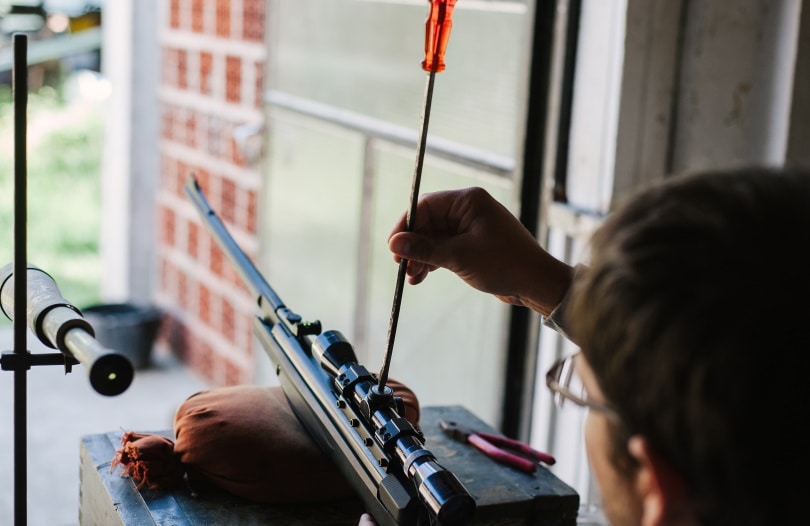
This is one of those things that new shooters and hunters don’t appreciate at first but can be a deal-breaker for an experienced hunter. After you zero your scope, your turrets will no longer be set to ‘0’ because you’ve adjusted them during the sighting-in process. Resettable turrets allow you to turn the turrets back to 0 without moving the reticle.
Why is this amazing? Because when you need to make adjustments for a specific shot that is at a different distance than you are zeroed at, you don’t have to remember what number the turrets were set to prior to your shot, and you don’t have to count clicks as you go; you can just make your adjustments and then turn back to zero when you’re done.
What Makes A Quality Image?
There are a few components to what makes a quality image in a rifle scope. The most common things that will come up are light transmission, color fidelity, sharpness, and image clarity.
Light Transmission
When light passes through a rifle scope, there is usually some form of loss in terms of how much light enters the objective lens and how much of it gets all the way through to your eye. There are a lot of things that affect light transmission, and here are the basic ones.
First is the objective lens diameter and the exit pupil. Ideally, the objective lens will be large enough that the exit pupil of the scope is the same size (or larger) as the pupil of your eye. The exit pupil of a scope is calculated by taking the diameter of the objective lens divided by the magnification. Once the exit pupil is as large as your eye’s pupil, there is no benefit to making it larger.
This is why you’ll see long-range scopes with massive objectives and Low power variable optics with much smaller objectives.
The second thing that affects light transmission is the quality of the glass or crystal used for the lenses. Not much to say here except that the higher the quality of the material, the better the light transmission will be.
The third thing is the multi-coating on the lenses. Coating is actually a big deal and can make a noticeable difference in the light transmission of a scope. Most of the name brands will have proprietary blends of coatings that they use on their lenses, and some are inherently better than others.
Color Fidelity
Not only does light bend as it goes through a lens, which can affect the coloration of the image, but the multi-coatings can also filter out certain colors of light more consistently than other colors. It may not be a big deal to you if the colors through your scope don’t perfectly match reality, but not only does it make the hours you spend looking through your scope more pleasant, it can help in the critical moments to find your target fast.
Sharpness

This is a tricky one for scope manufacturers and is one of the quickest ways to tell a budget scope from a high-end scope. As you get closer to the maximum zoom range, it’s not uncommon for the resolution of the image to go down or even for the image to get out of focus. The lenses have to be focused somewhere, and anything closer or farther from where the lenses are focused will get fuzzier as you zoom in tighter.
Sharpness is also affected by resolution even if everything is in focus. High-quality scopes will keep the resolution high as the magnification increases, while low-quality scopes will start to look like you’re watching an old television or a movie on VHS instead of keeping that crisp look.
Image Clarity
Image clarity is more of a catch-all word that encompasses all of these different factors, but it also includes things like chromatic aberration and distortion. It’s common for a low-quality scope to have distortions around the edges of the visible ring and to have certain colors blur at the edges, especially at higher magnification. Usually, this type of thing isn’t bad enough to really affect your shot, but it can, and it’s always distracting.
Important Things To Consider When Finding the Right Scope For .450 Bushmaster For Your Needs
So, what’s more important to you—image quality or features? There really isn’t a right answer because it all depends on what you shoot, how you shoot, and when you shoot. The third thing to consider besides features and image quality would be strength and durability. The cheaper the scope, the less likely it will last as long. Whether you measure scope lifespan in rounds shot or years owned, a $100 scope simply won’t compete with a $1,000 scope.

Conclusion
We hope these reviews were helpful as you look for the right scope for your .450 Bushmaster. One of the many great things about the Bushmaster is that because it’s intended to be used within 200 yards, there are tons of high-quality, affordable scopes to choose from. The list above is not all-inclusive and there are many other scopes that could have made the list.
Hopefully, this has given you a good lifting-off point and even shown you the right scope. The winner of best scope for .450 Bushmaster overall for us is the UTG BugBuster, and the best for the money is the Centerpoint Optics 1-4x. All these scopes are good choices and could work well given the right circumstances.
Featured Image Credit: Piqsels
Table of Contents
- Comparing the .450 Bushmaster
- A Quick Comparison of Our Favorites (2024 Update)
- The 6 Best Scopes for 450 Bushmasters
- Buyer’s Guide – Choosing the Best Scopes for .450 Bushmasters
- What Makes A Quality Image?
- Important Things To Consider When Finding the Right Scope For .450 Bushmaster For Your Needs
- Conclusion
About the Author Robert Sparks
Robert’s obsession with all things optical started early in life, when his optician father would bring home prototypes for Robert to play with. Nowadays, Robert is dedicated to helping others find the right optics for their needs. His hobbies include astronomy, astrophysics, and model building. Originally from Newark, NJ, he resides in Santa Fe, New Mexico, where the nighttime skies are filled with glittering stars.
Related Articles:
How to Clean a Refractor Telescope: Step-by-Step Guide
How to Clean a Telescope Eyepiece: Step-by-Step Guide
How to Clean a Rifle Scope: 8 Expert Tips
Monocular vs Telescope: Differences Explained (With Pictures)
What Is a Monocular Used For? 8 Common Functions
How to Clean a Telescope Mirror: 8 Expert Tips
Brightfield vs Phase Contrast Microscopy: The Differences Explained
SkyCamHD Drone Review: Pros, Cons, FAQ, & Verdict



